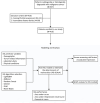Rapid identification of tumor patients with PG-SGA ≥ 4 based on machine learning: a prospective study
- PMID: 40394504
- PMCID: PMC12093709
- DOI: 10.1186/s12885-025-14222-9
Rapid identification of tumor patients with PG-SGA ≥ 4 based on machine learning: a prospective study
Abstract
Background: Malnutrition is common in cancer patients and worsens treatment and prognosis. The Patient-Generated Subjective Global Assessment (PG-SGA) is the best tool to evaluate malnutrition, but it is complicated has limited its routine clinical use.
Methods: We reviewed 798 records from 416 cancer patients treated at our hospital from July 2022 to March 2024. We used machine learning methods like XGBoost and Random Forest to find important factors linked to PG-SGA scores of 4 or higher. We confirmed the most important factors with logistic regression analysis.
Results: Among all models, XGBoost and Random Forest models perform the best, with the area under the curve (AUC) reaching of 0.75 and 0.77. Multivariate logistic regression analysis identified body mass index (BMI) (OR = 0.82, 95%CI 0.66-0.99; P = 0.045), handgrip strength (HGS) (OR = 0.89, 95%CI 0.82-0.96; P = 0.004), fat-free mass index (FFMI) (OR = 1.36, 95%CI 1.01-1.88; P = 0.045), and bedridden status (OR = 3.16, 95%CI 1.17-9.14; P = 0.026) as key predictors for PG-SGA scores of ≥ 4.
Conclusion: BMI, HGS, FFMI, and bedridden status were identified as practical indicators to efficiently screen patients likely to have PG-SGA scores ≥ 4.
Keywords: Cancer; Machine Learning; Nutritional Assessment; Patient-Generated Subjective Global Assessment.
© 2025. The Author(s).
Conflict of interest statement
Declarations. Ethics approval and consent to participate: All experiments involving human participants and/or human tissue samples in this study were performed in accordance with the Declaration of Helsinki and relevant institutional guidelines and regulations. Ethical approval was obtained from the Ethics Committee of Sichuan Provincial Cancer Hospital (Approval Number: SCCHEC-02–2022-066). Written informed consent was obtained from all participants prior to enrollment. Consent for publication: We confirm our consent for the manuscript titled “Rapid Identification of Tumor Patients with PG-SGA ≥ 4 Based on Machine Learning: A prospective Study” to be submitted for publication in BMC cancer. We agree to the submission of the manuscript and its contents to be published in the journal if accepted. Competing interests: The authors declare no competing interests.
Figures





Similar articles
-
Accuracy of isolated nutrition indicators in diagnosing malnutrition and their prognostic value to predict death in patients with gastric and colorectal cancer: A prospective study.JPEN J Parenter Enteral Nutr. 2022 Mar;46(3):508-516. doi: 10.1002/jpen.2199. Epub 2021 Jun 29. JPEN J Parenter Enteral Nutr. 2022. PMID: 34036614
-
Malnutrition Screening and Assessment in the Cancer Care Ambulatory Setting: Mortality Predictability and Validity of the Patient-Generated Subjective Global Assessment Short form (PG-SGA SF) and the GLIM Criteria.Nutrients. 2020 Jul 30;12(8):2287. doi: 10.3390/nu12082287. Nutrients. 2020. PMID: 32751724 Free PMC article.
-
Body Composition Measurement Improved Performance of GLIM Criteria in Diagnosing Malnutrition Compared to PG-SGA in Ambulatory Cancer Patients: A Prospective Cross-Sectional Study.Nutrients. 2021 Aug 10;13(8):2744. doi: 10.3390/nu13082744. Nutrients. 2021. PMID: 34444902 Free PMC article.
-
Validation of the Scored Patient-Generated Subjective Global Assessment (PG-SGA) in Thai Setting and Association with Nutritional Parameters in Cancer Patients.Asian Pac J Cancer Prev. 2019 Apr 29;20(4):1249-1255. doi: 10.31557/APJCP.2019.20.4.1249. Asian Pac J Cancer Prev. 2019. PMID: 31030501 Free PMC article.
-
Patient-Generated Subjective Global Assessment as a prognosis tool in patients with multiple myeloma.Nutrition. 2017 Apr;36:67-71. doi: 10.1016/j.nut.2016.06.009. Epub 2016 Jun 25. Nutrition. 2017. PMID: 28336110
References
-
- Yu H, Chen M, Zhang J. Nutritional assessment for 891 patients with common cancer in a cancer hospital of southwest China [J]. J clin oncol, 2024, 42(16_suppl): e23280-e.
-
- Kaźmierczak-siedlecka K, Skonieczna-żydecka K, Folwarski M, et al. Influence of malnutrition stage according to GLIM 2019 criteria and SGA on the quality of life of patients with advanced cancer [J]. Nutr hosp. 2020;37(6):1179–85. - PubMed
MeSH terms
LinkOut - more resources
Full Text Sources
Medical

